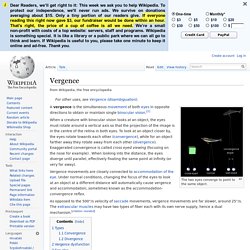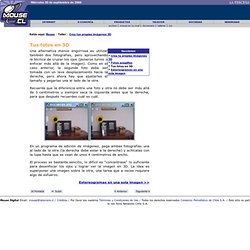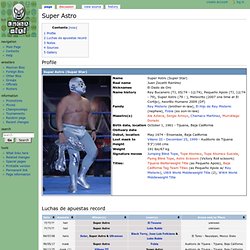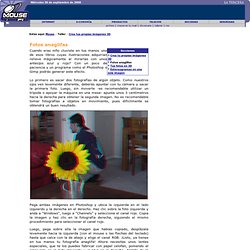

Anamorfosis de eduardo relero. Vergence. The two eyes converge to point to the same object.

When a creature with binocular vision looks at an object, the eyes must rotate around a vertical axis so that the projection of the image is in the centre of the retina in both eyes. To look at an object closer by, the eyes rotate towards each other (convergence), while for an object farther away they rotate away from each other (divergence). Exaggerated convergence is called cross eyed viewing (focusing on the nose for example) . When looking into the distance, the eyes diverge until parallel, effectively fixating the same point at infinity (or very far away). As opposed to the 500°/s velocity of saccade movements, vergence movements are far slower, around 25°/s. Types[edit] The following types of vergence are considered to act in superposition: Tonic vergence: vergence due to normal extraocular muscle tone, with no accommodation and no stimulus to binocular fusion. Autostereogram.
A random dot autostereogram encodes a 3D scene which can be "seen" with proper viewing technique ( ). Click on thumbnail to see full-size image. Cross-eyed vergence ( ).[1] Arrow indicates accommodation. The simplest type of autostereogram consists of horizontally repeating patterns (often separate images) and is known as a wallpaper autostereogram. Autostereograms are similar to normal stereograms except they are viewed without a stereoscope. History[edit] In 1838, the British scientist Charles Wheatstone published an explanation of stereopsis (binocular depth perception) arising from differences in the horizontal positions of images in the two eyes. Brewster also discovered the "wallpaper effect". In 1939 Boris Kompaneysky[5] published the first random dot stereogram containing an image of the face of Venus,[6] intended to be viewed with a device. How they work[edit] Simple wallpaper[edit] This is an example of a wallpaper with repeated horizontal patterns.
Color Stereo Stereograms by Gene Levine. 3-D Stereoscopic Animation short 'The Incredible Invasion' - 3-D Revolution Productions. The Incredible Invasion of the 20,000 Giant Robots from Outer Space Never before seen!

Thrill-Crazed Space Kids Elmer Kaan and Alexander Lentjes Present A Never Before Seen Shocking Space Story In 3-D Color Stop Motion Animation! You Are There! As The Amazing Flying Saucers Land At Every Panic Penetrated Home In Every Capital and Every Town! You Are There! SEE The Indestructible Fiends Of Outer Space Attack! It will Make You Fall Flat On Your Face With Horror!
"The Incredible Invasion Of The 20,000 Giant Robots From Outer Space" Currently, this here is the only location of the 3-D version of the animation. What to expect. Animated Stereograms / SIRDS / Hollusion. Callipygian 3d. Stereoscopic Photo Links / SYETEOeYe. Figurative Work - Terryfic 3D. Digital - Crea tus propias imágenes 3D.
Una alternativa menos engorrosa es utilizar también dos fotografías, pero aprovechando la técnica de cruzar los ojos (ponerse turnio o enfocar más allá de la imagen).

Como en el caso anterior, la segunda foto debe ser tomada con un leve desplazamiento hacia la derecha, pero ahora hay que ajustarles el tamaño y pegarlas una al lado de la otra. Recuerda que la diferencia entre una foto y otra no debe ser más allá de 3 centímetros y siempre saca la izquierda antes que la derecha, para que después recuerdes cuál es cuál. En un programa de edición de imágenes, pega ambas fotografías una al lado de la otra (la derecha debe estar a la derecha) y achícalas con la lupa hasta que se vean de unos 4 centímetros de ancho. El proceso es bastante sencillo, lo difícil es "concentrase" lo suficiente para desenfocar los ojos y lograr ver la imagen en 3D. La idea es superponer una imagen sobre la otra, una tarea que a veces requiere algo de esfuerzo.
Estereogramas en una sola imagen >> Super Astro - Luchawiki. Profile Luchas de apuestas record Notes Despite losing his mask in 1999, Super Astro started wearing in the mid to late 2000s.

He claims he was never paid by the promoter for losing his mask, so he has the right to continue wearing it. In at least one occasion, the commission objected to this. Current CMLL wrestler Valiente has often spoke being inspired to become a wrestler by Super Astro. Sources Super Astro's myspace. Imagenes 3D Con Lentes! Animated Stereograms / SIRDS / Hollusion. Vergence. Autostereogram. Digital - Crea tus propias imágenes 3D. Cuando eras niño ¿tuviste en tus manos uno de esos libros cuyas ilustraciones adquirían relieve mágicamente al mirarlas con unos anteojos azul y rojo?

Con un poco de paciencia y un programa como el Photoshop o Gimp podrás generar este efecto. Lo primero es sacar dos fotografías de algún objeto. Como nuestros ojos ven levemente diferente, deberás apuntar con tu cámara y sacar la primera foto. ASCII stereogram. ASCII stereograms are a form of ASCII art based on stereograms to produce the optical illusion of a three-dimensional image by crossing the eyes appropriately using a single image or a pair of images next to each other. To obtain the 3D effect (in Figure 1 for instance), it is necessary for the viewer to diverge their eyes such that two adjacent letters in the same row come together ( ). To help in focusing, try to make the two capital Os at the top look like three. Ensure that the image of the central dot is stable and in focus. Once this has been done, look down at the rest of the image and the 3D effect should become apparent. Figure 1: Near and far distances.